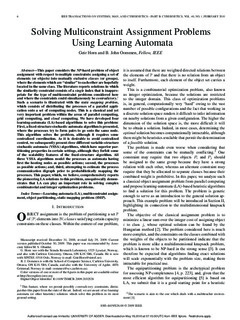| dc.contributor.author | Horn, Geir | |
| dc.contributor.author | Oommen, B. John | |
| dc.date.accessioned | 2010-11-29T12:59:08Z | |
| dc.date.available | 2010-11-29T12:59:08Z | |
| dc.date.issued | 2010 | |
| dc.identifier.citation | Horn, G. & Oommen, B.J. (2010). Solving Multiconstraint Assignment Problems Using Learning Automata. IEEE Transactions on Systems, Man, and Cybernetics, Part B: Cybernetics, vol. 40. no. 1. DOI:10.1109/TSMCB.2009.2032528 | en_US |
| dc.identifier.issn | 1941-0492 | |
| dc.identifier.uri | http://hdl.handle.net/11250/137841 | |
| dc.description | Published version of an article in the journal: IEEE Transactions on Systems, Man, and Cybernetics, Part B: Cybernetics. Personal use of this material is permitted. Permission from IEEE must be obtained for all other users, including reprinting/ republishing this material for advertising or promotional purposes, creating new collective works for resale or redistribution to servers or lists, or reuse of any copyrighted components of this work in other works | en_US |
| dc.description.abstract | This paper considers the NP-hard problem of object assignment with respect to multiple constraints: assigning a set of elements (or objects) into mutually exclusive classes (or groups), where the elements which are ldquosimilarrdquo to each other are hopefully located in the same class. The literature reports solutions in which the similarity constraint consists of a single index that is inappropriate for the type of multiconstraint problems considered here and where the constraints could simultaneously be contradictory. Such a scenario is illustrated with the static mapping problem, which consists of distributing the processes of a parallel application onto a set of computing nodes. This is a classical and yet very important problem within the areas of parallel computing, grid computing, and cloud computing. We have developed four learning-automata (LA)-based algorithms to solve this problem: First, a fixed-structure stochastic automata algorithm is presented, where the processes try to form pairs to go onto the same node. This algorithm solves the problem, although it requires some centralized coordination. As it is desirable to avoid centralized control, we subsequently present three different variable-structure stochastic automata (VSSA) algorithms, which have superior partitioning properties in certain settings, although they forfeit some of the scalability features of the fixed-structure algorithm. All three VSSA algorithms model the processes as automata having first the hosting nodes as possible actions; second, the processes as possible actions; and, third, attempting to estimate the process communication digraph prior to probabilistically mapping the processes. This paper, which, we believe, comprehensively reports the pioneering LA solutions to this problem, unequivocally demonstrates that LA can play an important role in solving complex combinatorial and integer optimization problems. | en_US |
| dc.language.iso | eng | en_US |
| dc.publisher | IEEE | en_US |
| dc.title | Solving Multiconstraint Assignment Problems Using Learning Automata | en_US |
| dc.type | Journal article | en_US |
| dc.type | Peer reviewed | en_US |
| dc.source.pagenumber | 6-18 | en_US |
| dc.source.journal | IEEE Transactions on Cybernetics | |
